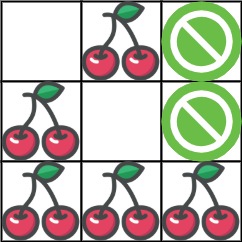
g0701_0800.s0741_cherry_pickup.Solution Maven / Gradle / Ivy
Go to download
Show more of this group Show more artifacts with this name
Show all versions of leetcode-in-java21 Show documentation
Show all versions of leetcode-in-java21 Show documentation
Java-based LeetCode algorithm problem solutions, regularly updated
package g0701_0800.s0741_cherry_pickup;
// #Hard #Array #Dynamic_Programming #Matrix #2022_03_25_Time_11_ms_(99.40%)_Space_42.5_MB_(90.61%)
/**
* 741 - Cherry Pickup\.
*
* Hard
*
* You are given an `n x n` `grid` representing a field of cherries, each cell is one of three possible integers.
*
* * `0` means the cell is empty, so you can pass through,
* * `1` means the cell contains a cherry that you can pick up and pass through, or
* * `-1` means the cell contains a thorn that blocks your way.
*
* Return _the maximum number of cherries you can collect by following the rules below_:
*
* * Starting at the position `(0, 0)` and reaching `(n - 1, n - 1)` by moving right or down through valid path cells (cells with value `0` or `1`).
* * After reaching `(n - 1, n - 1)`, returning to `(0, 0)` by moving left or up through valid path cells.
* * When passing through a path cell containing a cherry, you pick it up, and the cell becomes an empty cell `0`.
* * If there is no valid path between `(0, 0)` and `(n - 1, n - 1)`, then no cherries can be collected.
*
* **Example 1:**
*
* 
*
* **Input:** grid = \[\[0,1,-1],[1,0,-1],[1,1,1]]
*
* **Output:** 5
*
* **Explanation:** The player started at (0, 0) and went down, down, right right to reach (2, 2). 4 cherries were picked up during this single trip, and the matrix becomes [[0,1,-1],[0,0,-1],[0,0,0]]. Then, the player went left, up, up, left to return home, picking up one more cherry. The total number of cherries picked up is 5, and this is the maximum possible.
*
* **Example 2:**
*
* **Input:** grid = \[\[1,1,-1],[1,-1,1],[-1,1,1]]
*
* **Output:** 0
*
* **Constraints:**
*
* * `n == grid.length`
* * `n == grid[i].length`
* * `1 <= n <= 50`
* * `grid[i][j]` is `-1`, `0`, or `1`.
* * `grid[0][0] != -1`
* * `grid[n - 1][n - 1] != -1`
**/
public class Solution {
public int cherryPickup(int[][] grid) {
int[][][] dp = new int[grid.length][grid.length][grid.length];
int ans = solve(0, 0, 0, grid, dp);
return Math.max(ans, 0);
}
private int solve(int r1, int c1, int r2, int[][] arr, int[][][] dp) {
int c2 = r1 + c1 - r2;
if (r1 >= arr.length
|| r2 >= arr.length
|| c1 >= arr[0].length
|| c2 >= arr[0].length
|| arr[r1][c1] == -1
|| arr[r2][c2] == -1) {
return Integer.MIN_VALUE;
}
if (r1 == arr.length - 1 && c1 == arr[0].length - 1) {
return arr[r1][c1];
}
if (dp[r1][c1][r2] != 0) {
return dp[r1][c1][r2];
}
int cherries = 0;
if (r1 == r2 && c1 == c2) {
cherries += arr[r1][c1];
} else {
cherries += arr[r1][c1] + arr[r2][c2];
}
int a = solve(r1, c1 + 1, r2, arr, dp);
int b = solve(r1 + 1, c1, r2 + 1, arr, dp);
int c = solve(r1, c1 + 1, r2 + 1, arr, dp);
int d = solve(r1 + 1, c1, r2, arr, dp);
cherries += Math.max(Math.max(a, b), Math.max(c, d));
dp[r1][c1][r2] = cherries;
return cherries;
}
}
© 2015 - 2025 Weber Informatics LLC | Privacy Policy